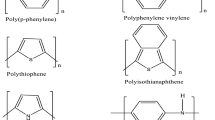Abstract
One of the most studied conducting polymers is polyaniline (PANI) which exists in different forms depending on its level of oxidation, and its conductivity can be determined depending on the level of the obtained oxidation state. The polymer can achieve some electrical conductivity properties by means of a doping process of the protonated form known as emeraldine salt (ES). Also, PANI is a polymer that has been widely studied because of its conductive properties, ease of preparation, low cost, and high chemical stability under normal environmental conditions; however, since it possesses a low processability, it is common to dope it in order to increase its conductive properties. In this study, PANI was obtained by the oxidation polymerization method and its deposition into thin films by the spin coating method.
Graphical abstract
PANI is a polymer that has been widely studied because of its conductive properties, its ease of preparation, its low cost and its high chemical stability under normal environmental conditions; however, since it possesses a low processability, it is common to dope it in order to increase its conductive properties. In this study, PANI was obtained by the oxidation polymerization method and its deposition into thin films by the spin coating method.




Similar content being viewed by others
Data availability
All datasets analyzed are available from the corresponding author on a reasonable request.
References
A.S. Hassanien, A.A. Akl, Effect of Se addition on optical and electrical properties of chalcogenide CdSSe thin films. Superlattices Microstruct. 89, 153–169 (2016). https://doi.org/10.1016/j.spmi.2015.10.044
P. Zarrintaj, Z. Ahmadi, H. Vahabi, F. Ducos, M. Reza Saeb, M. Mozafari, Polyaniline in retrospect and prospect. Mater. Today Proc. 5(7), 15852–15860 (2018). https://doi.org/10.1016/j.matpr.2018.05.084
J.H. Jeong, M. Jahandar, A. Prasetio, J.M. Kim, J.H. Kim, S. Kim, D.C. Lim, Multi-dimensional interfacial engineering for a practical large-area transparent flexible organic photovoltaics. Chem. Eng. J. 419, 129672 (2021). https://doi.org/10.1016/j.cej.2021.129672
M. Mozafari, N. Chauhan, eds., Polyaniline: an introduction and overview (2019). https://doi.org/10.1016/B978-0-12-817915-4.00001-4
A.J. Heeger, PANI with surfactant counterions-conducting polymer materials which are processible in the conducting form. Synth. Met. 57(1), 3471–3482 (1993)
A. Pron, J.-E. Österholm, P. Smith, A.J. Heeger, J. Laska, M. Zagorska, Processable conducting PANI. Synth. Met. 57(1), 3520–3525 (1993)
Y. Cao, P. Smith, A.J. Heeger, Counterion induced processibility of conducting PANI. Synth. Met. 57(1), 3514–3519 (1993)
P. Zarrintaj, B. Bakhshandeh, M.R. Saeb, F. Sefat, I. Rezaeian, M.R. Ganjali et al., Oligoaniline-based conductive biomaterials for tissue engineering. Acta Biomater. 72, 16–34 (2018). https://doi.org/10.1016/j.actbio.2018.03.042
M. Mozafari, Oligoaniline-based conductive biomaterials for tissue engineering. Acta Biomater. 72, 16–34 (2018)
M. Thangarathinavelu, A.K. Tripathi, T.C. Goel, I.K. Varma, Preparation and characterization of PANI–PVC polymer composite film. J. Appl. Polym. Sci. 51, 1347–1349 (1994)
P. Zarrintaj, M.R. Saeb, S. Ramakrishna, M. Mozafari, Biomaterials selection for neuroprosthetics. Curr. Opin. Biomed. Eng. 6, 99–109 (2018)
M. Mozafari, N. Chauhan (eds.), Fundamentals and Emerging Applications of Polyaniline (Elsevier, Amsterdam, 2019). https://doi.org/10.1016/B978-0-12-817915-4.00001-4
J. Vivekanandan, V. Ponnusamy, A. Mahudeswaran, P.S. Vijayanand, Synthesis, characterization and conductivity study of polyaniline prepared by chemical oxidative and electrochemical methods. Arch. Appl. Sci. Res. 3, 147.e153 (2011)
I.Y. Sapurina, M. Shishov, Oxidative polymerization of aniline: molecular synthesis of polyaniline and the formation of supramolecular structures, in New Polymers for Special Applications. ed. by A. De Souza Gomes (InTech, Winchester, 2012)
N.Y. Abu-Thabit, Chemical Oxidative Polymerization of Polyaniline: A Practical Approach for Preparation of Smart Conductive Textiles (Department of Chemical and Process Engineering Technology, Jubail Industrial College, Jubail Industrial City, 2016)
A.N. Andriianova, Y.N. Biglova, A.G. Mustafin, Effect of metal phthalocyanines on the synthesis and physicochemical properties of polyaniline. Mendeleev Commun. 30(5), 624–626 (2020). https://doi.org/10.1016/j.mencom.2020.09.024
B. Lee, H. Kim, H. Yang, Polymerization of aniline on bacterial cellulose and characterization of bacterial cellulose/polyaniline nanocomposite films. Curr. Appl. Phys. 12(1), 75–80 (2012). https://doi.org/10.1016/j.cap.2011.04.045
X. Zhang, W.J. Goux, S.K. Manohar, Synthesis of polyaniline nanofibers by “Nanofiber Seeding”. J. Am. Chem. Soc. 126(14), 4502–4503 (2004). https://doi.org/10.1021/ja031867a
Acknowledgements
Juan Carlos Carranza Cruz is grateful to CONACyT for his Scholarship. We also thank Tecnológico Nacional de México (TecNM) for Project 11809.21-P, for their financial support.
Funding
This research was funded by Tecnológico Nacional de México, TecNM under Grant Agreement No. 11809.21-P.
Author information
Authors and Affiliations
Corresponding author
Ethics declarations
Conflict of interest
All authors certify that they have no affiliations with or involvement in any organization or entity with any financial interest or non-financial interest in the subject matter or materials discussed in this manuscript.
Additional information
Javier Illescas was an editor of this journal during the review and decision stage. For the MRS Advances policy on review and publication of manuscripts authored by editors, please refer to mrs.org/editor-manuscripts.
Rights and permissions
About this article
Cite this article
Carranza-Cruz, J.C., Rivera, E., Santana, G. et al. Synthesis of polyaniline (PANI) through chemical oxidation for its preparation in thin films. MRS Advances 6, 965–968 (2021). https://doi.org/10.1557/s43580-021-00178-y
Received:
Accepted:
Published:
Issue Date:
DOI: https://doi.org/10.1557/s43580-021-00178-y




